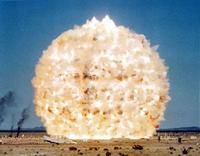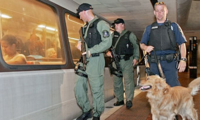-
U.S. to keep Cuba on list of states sponsoring terrorism
The State Department said Wednesday that the Obama administration will not remove Cuba from the list of states sponsoring terrorism. Other countries on the list include Iran, Syria, and Sudan. The list is updated annually. Cuba sheltered Colombian and Basque terrorists, but with peace negotiations in Colombia, and with the Basque separatists announcing the end of their armed struggle, some analysts thought Cuba would be removed from the list this year.
-
-
House panel to hold hearings on marathon bombing
Representative Michael McCaul (R-Texas) said theHouse Homeland Security Committee will meet next week to hear testimony from Boston Police Commissioner Ed Davis and discuss the Boston Marathon bombing response methods and its implications for homeland security. “This will be the first in a series of hearings, as part of a broader investigation into the Boston Marathon bombings,” McCaul told reporters.
-
-
Woman who killed N.J. trooper in 1973 makes the FBI’s most wanted list
Joanne Chesimard, a former member of the Black Liberation Army who killed a New Jersey state trooper in 1973, has become the first woman to make the FBI’s most wanted list. The reward for her capture and arrest has doubled to $2 million. In 1979 Chesimard escaped jail, and since 1984 has been living in Cuba, using the name Assata Shakur.
-
-
Three of Dzhokhar’s friends charged with destroying evidence (Updated)

Three college students have been arrested on suspicion that they helped Dzhokhar Tsarnaev destroy evidence which would have provided details about his and his brother’s preparations for the marathon bombing. One of the three then lied to police when asked about their actions. The three are likely to face charges of conspiracy to obstruct justice. One of three will also be charged with lying to federal investigators.
-
-
Three friends of Dzhokhar arrested, charged with destroying evidence
Three college students have been arrested on suspicion that they helped Dzhokhar Tsarnaev destroy evidence which would have provided details about his and his brother’s preparations for the marathon bombing. One of the three then lied to police when asked about their actions. The three are likely to face charges of conspiracy to obstruct justice. One of three will also be charged with lying to federal investigators.
-
-
Canada considered deporting train terror suspect – but he was stateless
Raed Jaser, who is accused of planning an “al Qaeda supported” bomb attack aiming to derail a Canadian passenger train, was arrested nine years ago in Toronto and was facing deportation because he had a criminal record. Jaser is a Palestinian who grew up in the UAE. The UAE never gave his family a UAE citizenship, and they refused to take him back. The Canadian authorities say his case is not unique.
-
-
DHS chemical plant security program hobbled by problems, poor oversight
A DHS program responsible for the security of chemical facilities, such as the West Fertilizer Company plant in Texas, has been ineffective owing to a number of issues, leading federal investigators to wonder “whether it can achieve its mission, given the challenges the program continues to face.”
-
-
Female DNA found on Boston bomb fragments
FBI investigators found female DNA on fragments from the bombs used in the Marathon attack. The finding was first reported in the Wall Street Journal. Mikhail Allakhrdov, a man who some of Tsarnaev’s family members and friends described as the mysterious “Misha” who radicalized Tamerlan, said that he had not been in contact with Tsarnaev for several years, and that he never encouraged him to take up violence. Allakhrdov, a Ukrainian Christian who converted to Islam, admitted that a few years ago he was Tsarnaev’s “spiritual tutor.”
-
-
FBI looking for a “person of interest” who may have helped the Tsanaev brothers
Lawmakers with knowledge of the investigation into the Boston marathon bombing said over the weekend that law enforcement agencies are looking for a “person of interest” who may have been involved with the Tsarnaev brothers in preparing the attack. The lawmakers highlighted the fact that law enforcement agencies are not convinced that the brothers acted alone, without any help of one or two more people.
-
-
Jewish Security Summit discusses communal safety
Leaders from the Jewish Federations of North America (JFNA) and other Jewish organizations gathered last week at the first Jewish Communal Security Summit in New York to strategize with top experts in the field how best to keep the community safe.Security providers from around the country had a chance to learn about best practices in threat assessment and response in the current climate.
-
-
New fertilizer can be used to grow food – but not build bombs

Ammonium nitrate fertilizer is used in agriculture, but when mixed with a fuel such as diesel, it is highly explosive. It was used in about 65 percent of the 16,300 homemade IEDs in Afghanistan in 2012.About 1,900 troops were killed or wounded in IED attacks in 2012, 60 percent of American combat casualties. There have been more than 17,000 global IED incidents in 123 countries in the past two years. Timothy McVeigh used ammonium nitrate in Oklahoma City in 1995. Scientists have developed a fertilizer that helps plants grow but cannot detonate a bomb.
-
-
Tamerlan Tsarnaev's name was on U.S. terror watchlist since 2011

In March 2011, after being contacted by the Russian security services, the CIA added the name of Tamerlan Tsarnaev to the U.S. government’s terror watchlist. DHS secretary Janet Napolitano said that Tamerlan’s travel to Dagestan, and his arrival back in the United States, were “pinged” by the department. Leading lawmakers have raised questions about whether the U.S. intelligence community and law enforcement agencies have dropped the ball on the Tsarnaev brothers.
-
-
Atlanta losing DHS area security grant money
The city of Atlanta is losing DHS grant money used to strengthen the city’s ability to protect against a terrorist attack. Despite being home to recent high profile events such as the NCAA’s Final Four, federal records show the amount of money allocated to Atlanta through urban area security grants has dropped from $13 million in 2010 to $5 million last year.
-
-
Dzhokhar Tsarnaev had no firearms, explosives with him when captured
More details have emerged to shed light on the last few hours before 19-year old Dzhokhar Tsarnaev was captured hiding on a boat in Watertown, Massachusetts. Tsarnaev had no weapons or explosives with him in the boat where he was hiding. Boston police officers say that the heavy fire directed at the boat was probably the result of chaos of the moment. In a tense and charged atmosphere, one accidental shot could have caused what police call “contagious fire.” Tsarnaev sustained severe injuries, some of them to his neck and lower jaw, preventing him from talking. This led to rumors in the press that he tried to take his own life, but failed. We now know that he could not have tried to take his life because he had no firearms with him on the boat.
-
-
Experts: security of U.S. mass transit system must be tightened

Counterterrorism experts are arguing that security on America’s mass transit lines must be tightened in light of the foiled plot to attack a Toronto passenger train. The plan to attack Canada’s transit system highlights security holes in America’s commuter system, and the challenges involved in securing this vast system.
-
More headlines
The long view
What Does Netflix’s Drama “Adolescence” Tell Us About Incels and the Manosphere?
While Netflix’s psychological crime drama ‘Adolescence’ is a work of fiction, its themes offer insight into the very real and troubling rise of the incel and manosphere culture online.
